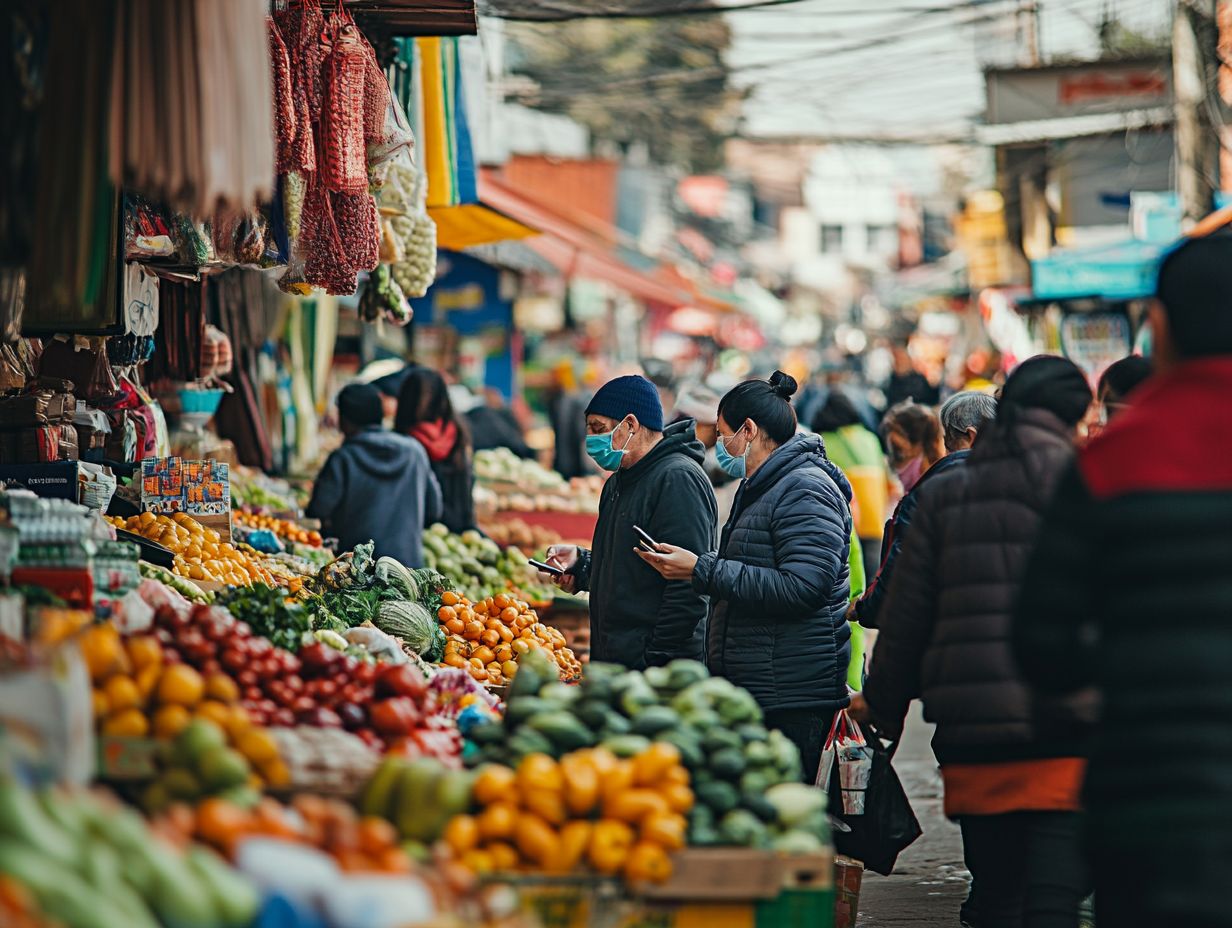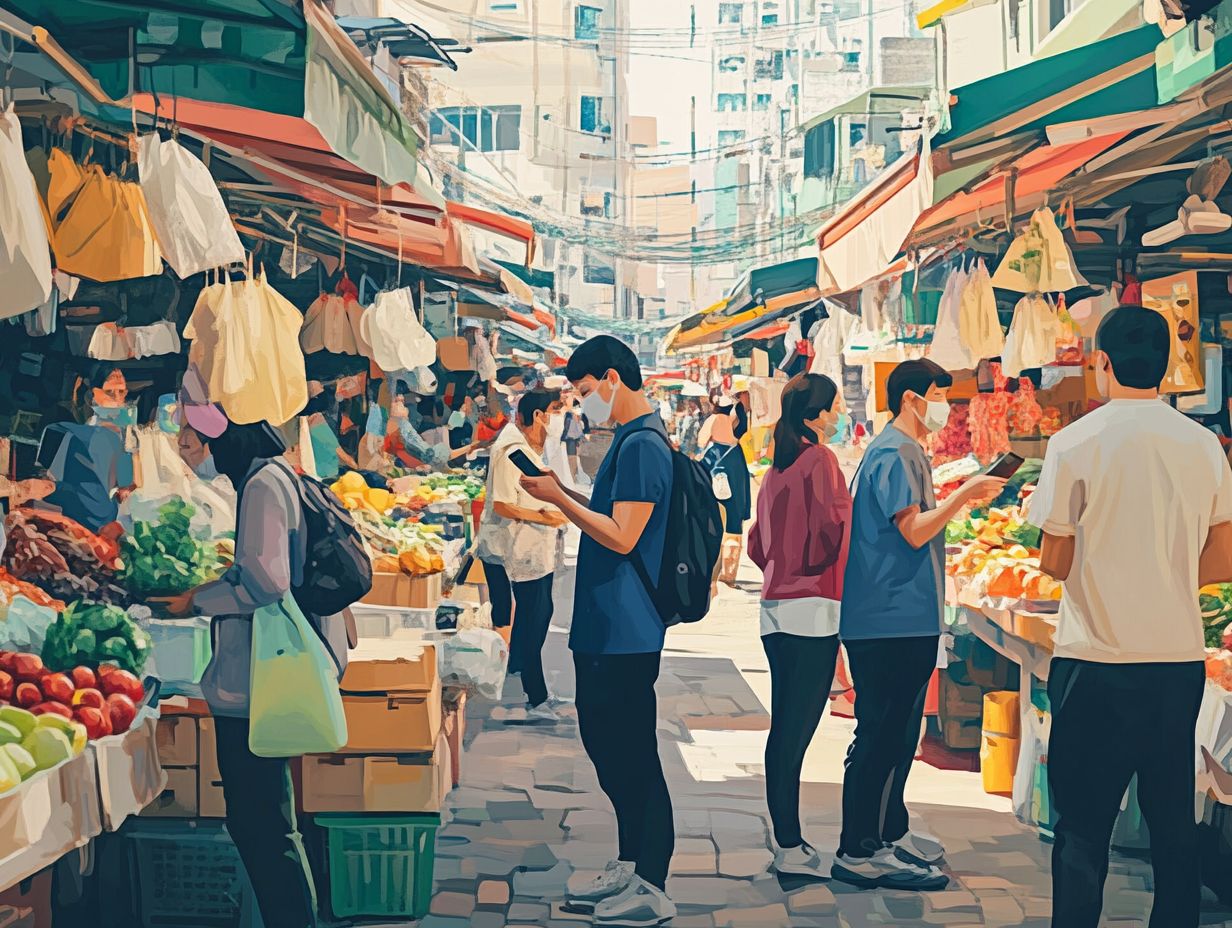Market Trends in Consumer Behavior Post-Pandemic
The pandemic has profoundly transformed the way you think and behave as a consumer. This shift has resulted in notable changes in spending habits, brand loyalty, and the overall shopping experience.
Grasping these changes is essential for businesses striving to flourish in this new landscape. From the rise of e-commerce to shifting consumer priorities, this article delves into the key transformations in consumer behavior and the strategies companies are employing to remain relevant.
Dive into these exciting trends now!
Contents
- Key Takeaways:
- Overview of Post-Pandemic Consumer Behavior
- The Impact of the Pandemic on Consumer Spending
- E-commerce and Online Shopping Trends
- Changes in Brand Loyalty and Consumer Preferences
- How Businesses are Adapting to the Changing Consumer Landscape
- Predictions for the Future of Consumer Behavior
- Frequently Asked Questions
- What are the current market trends in consumer behavior post-pandemic?
- How has the pandemic affected consumer spending habits?
- Are there any changes in consumer preferences post-pandemic?
- Have there been any long-term effects on consumer behavior as a result of the pandemic?
- How have businesses adapted to these changes in consumer behavior?
- Is there a particular demographic that has been most affected by the pandemic’s impact on consumer behavior?
Key Takeaways:

- Consumer spending patterns and priorities have shifted post-pandemic, with an increase in online shopping and a reevaluation of brand loyalty.
- Businesses must adapt to the changing consumer landscape by implementing innovative strategies and tactics to stay successful.
- Experts predict that post-pandemic, consumer behavior will continue to be heavily influenced by new factors, and e-commerce will remain a dominant trend in the market.
Overview of Post-Pandemic Consumer Behavior
The COVID-19 pandemic has profoundly transformed consumer behavior, prompting significant shifts in how you prioritize spending and engage with brands. As you adapted to remote work, online shopping surged, and new forms of brand loyalty took root, placing a heightened emphasis on health and wellness.
Economic uncertainty drove you to seek out eco-friendly choices, making sharing brand stories and authentic customer relationships vital for brands navigating this new landscape. Understanding these behavioral changes is crucial for your business if you aim to thrive in a post-pandemic world, where virtual interactions and self-improvement have become the norm.
Key Changes in Consumer Habits and Attitudes
Key changes in consumer habits and attitudes have emerged directly in response to the COVID-19 pandemic, reflecting a shift toward more thoughtful purchasing decisions. You are increasingly prioritizing health and wellness.
E-commerce platforms are adapting to meet your evolving needs through enhanced virtual interactions and convenient shopping experiences. This transformation signifies a departure from previous habits, urging brands to innovate and align with your new mindset.
Take Peloton, for example. They ve thrived by creating engaging fitness communities and offering streaming workouts tailored for those of you seeking to maintain your health while at home.
Similarly, skincare brands like Glossier have capitalized on the rise of social media influencers, fostering connections and delivering personalized shopping experiences that seamlessly blur the lines between retail and lifestyle. These examples illustrate that companies are not merely selling products; they are providing solutions that resonate with a digital-savvy demographic like yours.
One that values accessibility, authenticity, and overall well-being.
The Impact of the Pandemic on Consumer Spending
The pandemic has significantly influenced your spending patterns, leading to a marked change in how and where you decide to allocate your financial resources. In the face of economic uncertainty, you may find yourself prioritizing essential purchases while curbing discretionary expenses.
This transformation not only impacts your brand loyalty but also underscores the necessity for businesses to evolve their offerings and marketing strategies to align with your shifting needs and preferences. Join the movement towards smarter shopping!
Shifts in Spending Patterns and Priorities
Shifts in spending patterns have become clear due to the pandemic. You’re now focusing your financial decisions on essentials and experiences that enhance your well-being.
This reallocation of resources reveals a deeper awareness of health and wellness. It prompts brands to rethink their product offerings and marketing strategies to connect with your evolving values.
A recent study highlights that 44% of shoppers, like you, have significantly increased their spending on essential goods such as groceries and personal care items. This illustrates a marked shift away from discretionary purchases like dining out and luxury items.
Nearly 60% of consumers are now prioritizing products that support their physical and mental health, reflecting a collective desire for wellness-oriented lifestyles.
As a result, businesses are adapting by emphasizing using eco-friendly materials and health benefits, aligning their strategies with your emerging priorities. This trend indicates immediate financial adjustments and signifies a fundamental shift in how you and others view overall well-being in the long term.
E-commerce and Online Shopping Trends

E-commerce has witnessed remarkable growth during the pandemic, fundamentally reshaping your shopping habits and preferences. As you and many others turned to online platforms to fulfill your needs, the emergence of contactless payments which allow you to pay without physical contact for safety and click-and-collect services became essential, offering both convenience and safety.
This transformation is exciting! It shows how retail is changing fast and mirrors broader trends in consumer behavior that are likely to leave a lasting mark long after the pandemic subsides.
Rise in Online Shopping and its Effects on Traditional Retail
The rise of online shopping has profoundly impacted traditional retail, compelling you to adapt or rethink your business model to stay competitive. With consumers increasingly gravitating towards the convenience of e-commerce, it’s essential for you to explore new strategies that enhance the in-store experience and drive foot traffic.
Acting now is crucial, as ignoring this trend could result in huge losses. This shift requires you to rethink your approach, blending digital and physical storefronts in a seamless manner.
Take inspiration from major chains like Best Buy, which have adopted a strategy that combines both online and in-store shopping to enhance customer engagement both online and in-store. This led to a notable 20% increase in same-store sales in recent years.
Did you know that 67% of shoppers prefer retailers that provide personalized experiences? This underscores the necessity for you to innovate continuously. By investing in technology and redesigning your spaces, you not only mitigate potential losses but also capture new market segments eager for unique shopping experiences.
Changes in Brand Loyalty and Consumer Preferences
The pandemic has triggered profound shifts in brand loyalty and consumer preferences, and this urges you to rethink how you connect with your customers in a deeper way.
With health and wellness now at the forefront of consumer concerns, businesses that embrace sustainable practices and weave compelling narratives are finding themselves in a stronger position to foster loyalty.
This evolution marks a significant change, as consumers increasingly seek out brands that resonate with their values and offer enriching experiences.
New Factors Influencing Consumer Choices
New factors are reshaping your choices as a consumer, significantly altering your expectations from brands and the marketplace. With a heightened focus on health and wellness, you seek not just quality products but also brands that prioritize sustainability and ethical practices.
This marks a notable shift in what drives your loyalty and purchasing decisions. You are increasingly motivated by the values behind your purchases. You tend to choose brands that are transparent about their sourcing and production processes.
Statistics reveal that 66% of global consumers, like yourself, are willing to pay more for sustainable brands. This reflects a robust market trend that many companies are now embracing.
Imagine brands like Patagonia, leading the way in environmental responsibility. Similarly, The Body Shop has long championed ethical sourcing, demonstrating that aligning with consumer values can cultivate a profound connection and loyalty.
How Businesses are Adapting to the Changing Consumer Landscape
Considering the swiftly evolving consumer landscape, you ll find that businesses are embracing innovative strategies to stay relevant and competitive in the world after COVID-19. As remote work and virtual interactions become the norm, companies are discovering new avenues to engage consumers.
They are harnessing technology to elevate customer experiences while skillfully managing the challenges posed by economic uncertainty. This adaptable mindset is essential for cultivating resilience and paving the way for long-term success.
Innovative Strategies and Tactics for Success

Innovative strategies and tactics are now essential for you as you navigate a rapidly evolving market. By leveraging virtual interactions, you can enhance consumer engagement through personalized experiences.
Take Nike, for instance. They ve effectively utilized social media campaigns to build community and deepen brand loyalty, resulting in a notable increase in direct online sales.
If you embrace augmented reality (AR) technology that allows you to see virtual images overlaid on the real world you could see similar impressive engagement metrics. Consider beauty brands like L’Or al, which allow customers to virtually try on makeup, leading to significantly improved conversion rates.
These examples highlight how adapting proactively to digital marketing trends not only meets consumer expectations but also transforms challenges into opportunities for growth and brand differentiation.
Predictions for the Future of Consumer Behavior
As you gaze into the future, don t miss out! The future is bright for brands that adapt to consumer values.
Experts anticipate that the focus on online shopping will remain strong. Consumers will increasingly gravitate toward brands that prioritize ethical practices and environmental responsibility.
This evolution will reshape the retail landscape and redefine customer relationships in meaningful and profound ways.
What Experts Say About Future Consumer Trends!
Expert insights and forecasts offer invaluable perspectives on the trajectory of consumer behavior in the coming years. They shed light on key trends that will shape the marketplace. Analysts emphasize the growing importance of health and wellness, sustainability, and the integration of technology as central themes that will redefine your expectations and interactions with brands.
As consumers become more health-conscious, brands are shifting to provide cleaner ingredients and greater transparency in sourcing. A recent report reveals that nearly 80% of shoppers prioritize health benefits when making purchasing decisions.
Sustainability has evolved from a buzzword to a critical expectation. Studies show that many consumers are eager to spend up to 10% more on environmentally friendly products, reflecting a genuine commitment to the planet.
The rise in digital engagement indicates a shift towards personalized experiences, using data to understand customer preferences. This highlights the need for brands to adapt quickly to remain relevant in this ever-evolving landscape.
Frequently Asked Questions
What are the current market trends in consumer behavior post-pandemic?
Current market trends in consumer behavior post-pandemic include increased online shopping, a focus on health and wellness products, and a shift towards sustainable and ethical purchasing.
How has the pandemic affected consumer spending habits?

The pandemic has made consumers more cautious with their spending and has led them to prioritize essential purchases. This cautiousness has resulted in a decrease in overall consumer spending, particularly in travel and entertainment.
Are there any changes in consumer preferences post-pandemic?
Yes, there have been significant shifts in consumer preferences. Examples include a preference for contactless payments, increased demand for home delivery services, and a desire for products that promote hygiene and cleanliness.
Have there been any long-term effects on consumer behavior as a result of the pandemic?
There will likely be long-term effects on consumer behavior post-pandemic. For instance, the rise in remote work and online shopping may continue even after the pandemic ends. Consumers may also become more conscious of their health and hygiene habits.
How have businesses adapted to these changes in consumer behavior?
Businesses have had to adapt quickly to survive. This includes implementing safety measures, offering online and contactless options, and pivoting to meet the demand for specific products and services.
Is there a particular demographic that has been most affected by the pandemic’s impact on consumer behavior?
The pandemic has impacted various demographics differently. Overall, younger generations and lower-income individuals have been hit the hardest, experiencing job losses, financial struggles, and a shift in purchasing power.
Want to keep up with these trends? Subscribe for more expert insights!






